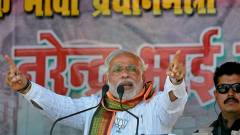The three points that he epitomised were change, youth aspirations, and leadership
It’s been just over two months since Narendra Modi, a staunch supporter of Hindutva, was sworn in as the 15th prime minister of India after his Bharatiya Janata Party (BJP) won an astounding victory in the Lok Sabha elections.
This thumping victory, giving BJP absolute majority in parliament on its own, was largely attributed to one man only, Narendra Modi, who addressed more than 300 election rallies across the length and breadth of the country, often delivering fiery speeches and telling his audience what they really wanted to hear.
The three points that he epitomised were change, youth aspirations, and leadership. He also used the social network to woo young voters. Narendra Modi blogged, tweeted, and Facebooked, and it was thought that India’s youth have now found a real leader who would fulfill their aspirations.
But all of a sudden the fiery and vocal Modi has gone on “mute” mode. His close followers are trying to convince the people of India that their leader is a man of action and does not believe in talking too much to the media.
One very clearly remembers that former prime minister Dr Manmohan Singh was severely criticised for being a person who would hardly communicate. There were rounds going in New Delhi that, when he went to his dentist, he had to plead to Dr Singh to at least “open his mouth” in his clinic. Dr Singh’s stony silence was understandable; it was perceived to be merely an act of following orders. But, Modi is known to be his own master and his silence is looked upon as “a silence of choice and convenience.”
As a result, when on many issues, clarity on the part of the government is of utmost importance, this silence is giving a confusing message to the country. One point that many analysts talk about is that Narendra Modi does not feel very comfortable with the media and that he is also known to have lost his temper when faced with probing questions from journalists. He is also known to have asked his ministers not to speak to reporters out of turn.
Narendra Modi does not want to get trapped by the media in any way, and would prefer to use social media networks to keep the youth on his side – this is what his brigade is working at.
Others say that talking big and nasty when in opposition and during election rallies is one thing, while governance in a massive country with such diversity is a “totally different ball-game” altogether. It was thought that his formula of development in Gujarat could be replicated in the rest of India, but no definite plans or policies are in sight.
Another important facet political analysts have always pointed to is that the BJP-led government would largely be controlled by the Rashtriya Swayamsevak Sangha (RSS), whose cadres worked all over the country in the election campaign. There was always a fear that there could be a remote-button to be pressed by the RSS in the running of the government. Many believe that BJP/RSS have already started working on a hidden agenda of Hindutva, and that Narendra Modi does not really want to open his mouth on that issue to the media.
Elections to state assemblies are due in a number of states later in the year, most notably in Maharastra and Haryana, and BJP, with Amit Shah made party head recently, is busy hatching plans to take large swathes of the country in these elections. BJP/RSS nexus is working towards it stealthily and in a divisive manner.
This silence on the part of the prime minister of India, coupled with failure to deliver on some of the election campaign promises, has raised questions within the party. BJP won all the seven of the Lok Sabha seats in the capital Delhi, but is still unsure whether to go for the polls or start horse-trading and woo members of the state assembly from other parties and independents to its fold to muster the required majority.
In the elections held last December, the Aam Aadmi Party (AAP), led by Arvind Kejriwal, with the support of Congress, formed the Delhi state government, only to resign after 45 days in power. BJP and its ally bagged 32 seats in the 70-seat state assembly, but with three of its members becoming MPs, their strength has gone down to 29, and one of AAP’s member being ousted from the party, their strength has been reduced to 27 in the now 67-seat assembly. BJP had been accused of “trying to buy MLAs” and form the government.
But it now transpires that the BJP would go for an election after the RSS had shown displeasure at some MLAs’ inclination to grab power despite not having the numbers. RSS was reported to be displeased by the attitude of some BJP MLAs. But, the round going in Delhi is that these MLAs fear that they would lose if fresh polls are held.
The recent price hike of essential commodities has also put the BJP on the back foot, and so the party is also wary of what Delhi results would look like if elections were held now.
Obviously, no party would like to be blemished so soon after coming to power, but it appears that the only way out in Delhi is holding fresh elections to the state assembly. BJP would like to tighten its grip on the capital before coming to a concrete decision.
The big question to pose is: Will Modi open his mouth now? His continued silence is becoming more and more deafening by the day, and however he may try to prove that his work would do the talking, his countrymen and the world would also like to point out that talking is an integral part of his work.
Source: Dhaka Tribune










